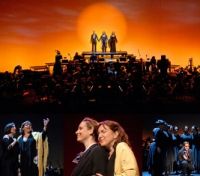
Ainadamar: A Tragic Ode to Freedom
Once again, Cincinnati Opera has outdone itself with its production of Osvaldo Golijov’s Ainadamar, third of the four Spanish-themed operas that make up its 2009 summer festival.

Performed June 9 and 11 at Music Hall, it was a most challenging project for both artist and listener, due
to its substantial elements of cultural diversity. However, with every
challenge, there must be strong foundational support. In this
regard, we have been blessed with the creativity, the immense
imagination and ingenuity of Osvaldo Golijov.
The focus of the opera turns to Federico in the second image. The balada repeats, this time more dissonant and irritated than the first. Margarita tries to convince Lorca to escape to Havana, which Lorca refuses. Lorca’s arrest results in his execution with a bullfighter and a teacher. The image concludes with the gun shots of the execution, cleverly sequenced through a laptop in daunting flamenco rhythms.
Margarita becomes the central figure of the third image, which consists of her collapse and coming to terms with her imminent death, in which she finds peace and freedom. The balada is repeated one final time. Rhythmically stretched and in a slower tempo than the first three, the balada is Margarita’s eternal cry for freedom in death, and hope for freedom in life.
Mr. Golijov’s longtime collaborator, soprano Dawn Upshaw, was beautifully cast in voice and character as the Spanish actress Margarita Xirgu. From the first trumpet call in the opening balada, she portrayed the suffering that consumed Margarita for her dead idol, Federico García Lorca. Soprano Jessica Rivera played Nuria, the student of Margarita. Nuria’s empathy for her loving teacher was exquisitely expressed by Rivera’s seamless tone, and sentimental gestures of understanding for Margarita’s tragic loss and constant suffering. Jesús Montoya in the role of Lorca’s arresting officer, Ramón Ruíz Alonso, brought to life the composer’s adaptation of the “cante jondo,” or “deep song.” His character’s condemnation of Lorca was expressed as a gypsy cry supported by the flamenco rhythmical, linguistic sense.
Last but not least, was mezzo-soprano Kelley O’Connor in the role of Lorca. I must admit in my short life span I have not heard such a beautiful contralto tone. It has a sublime quality and luscious velvet color, rarely heard in such a low register. However, Ms. O’Connor’s angelic personality, which emanates not only from her person, but is transparent in her voice, was no match for the character of Lorca, who was once described by a close friend and soul-mate, Salvador Dalí, as having “a strong physical presence, dominance, charm, and magnetism.”
In lieu of some diction and dancing inconsistencies, the grandeur of the larger picture made these but minutiae.
For this production, the orchestra, comprising members of the Cincinnati Symphony with guest performers on flamenco guitar and percussion, was positioned center stage rather than in the conventional pit. This detracted from the dramatic drive of the plot, not to mention the various occasions where the balance between orchestra, singer and chorus was offset by the mere fact of the orchestra’s position. However, conductor Miguel Harth-Bedoya did a superb job of making the orchestra and his leadership as unobtrusive as possible.
The star of this production is Cincinnati Opera. We, as Cincinnatians should be proud of such a fine and prestigious artistic institution, which has withstood the test of time approaching its 90th anniversary next season. This company has dared to delve into uncharted territory by investing itself wholly into bringing new, avant-garde productions to life. As an audience, we have grown wiser and more knowledgeable, not only about music and voice, but by gaining a better understanding of cultural differences in a world where such boundaries are receding, making us better human beings. Bravo Cincinnati Opera!
(Editor's note: Antoine López is a composer pursuing his undergraduate degree at the University of Cincinnati College-Conservatory of Music.)